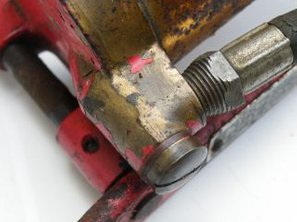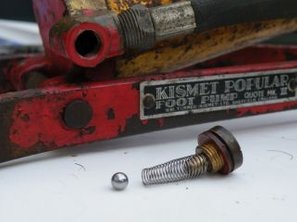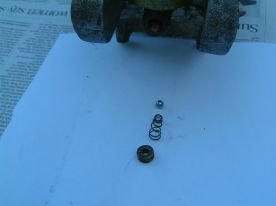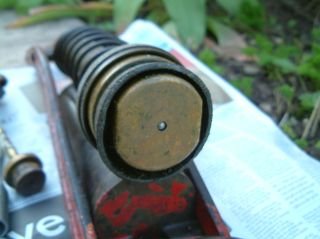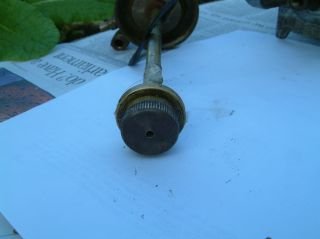Non Return Valves
All foot pumps require a non return valve. This allows air out from the pump into the hose on the downstroke when pumping, put prevents air returning from the tyre to put back pressure on the pump during the upstroke. High quality vintage foot pumps have the non-return valve located internally in the pump body, or at the point of connection to the hose.
These pictures show a Kismet Popular non return valve, assembled and dismantled. It's located internally in the pump at the point of connection of the hose and it it typical of those on many old pumps. Its very simple - a small ball bearing is located in the orifice at the air outlet and held in place with a soft spring and brass bolt - which can be easily undone. Be careful not to lose the ball bearing! When pumping, the ball bearing is forced outwards against the spring, letting air flow through the annulus into the hose. When pumping stops, the reverse pressure in the tyre and hose - helped ( a bit) by the spring - forces the ball bearing back and blocks the airway. But the spring is essentially to locate the ball bearing in the right place - it is very weak and the main closing job is done by the reverse pressure. These non return valves are basically maintenance free - but not a bad idea to dismantle, inspect the spring/ ball bearing periodically and squirt some oil into the hole to keep everything free. A rusty or pitted ball bearing should be replaced.
Another somewhat similar arrangement is shown in a Wood Milne below. Here a small threaded insert locates a spring and ball bearing in the main outlet air channel under the pressure gauge. This functions in exactlly the same way as in the Kismet Popular above. The threaded insert allows some adjustment and compression of the spring to 'tune' the airflow.
In a number of more complicated pump designs, the ball bearing/spring non return valve is located deeper inside the pump. The pictures below show a N/R walve incorporated in the head of the main piston in a Kismet Sequel. This is positioned to prevent backflow but to allow air compressed by the piston to transfer forwards into a large diameter piston rod - which acts as a reservoir prior to air entering the tyre. This smooths the airflow and allows higher pressures to be attained. This idea was patented by Kismet. It also appears in the Kismet Lorry, Kismet 85 and all the large PCL and Dunlop pumps.
In the two stage Kismet Duplex and Duplex Master, the N/R valve is incorporated in the small high pressure piston - see below - which provides the second stage of compression
In some smaller pumps, there is not a N/R valve in the pump body, but one is incorporated as a tiny ball bearing in the hose connector - which joins the hose to the pump. This is the case in the Aerite, Nesthill Jupier, Prima and some other pumps. Generally, these cannot be dismantled and repaired if they fail and a new connector is needed.
